2.Mitosis - Meiosis & Genetics
1/20
There's no tags or description
Looks like no tags are added yet.
Name | Mastery | Learn | Test | Matching | Spaced |
|---|
No study sessions yet.
21 Terms
Mitosis vs. Meiosis
🧠 Flashcard Questions Mitosis
Q: What is the main purpose of mitosis?
A: Growth and repairQ: How many daughter cells are produced in mitosis?
A: 2Q: Are the daughter cells in mitosis diploid or haploid?
A: Diploid (2n)Q: Are mitotic daughter cells genetically identical or different?
A: Identical
Meiosis
Q: What is the purpose of meiosis?
A: To produce gametes for reproductionQ: How many divisions occur in meiosis?
A: TwoQ: How many daughter cells result from meiosis?
A: FourQ: Are the daughter cells in meiosis haploid or diploid?
A: Haploid (n)Q: Are meiotic daughter cells genetically identical?
A: No, they are genetically different
📊 Mitosis vs. Meiosis – Table Summary
Feature | Mitosis | Meiosis |
|---|---|---|
Purpose | Growth and repair | Reproduction (gamete formation) |
# of Divisions | 1 | 2 |
# of Daughter Cells | 2 | 4 |
Chromosome Count in Daughter Cells | Diploid (2n) – same as parent | Haploid (n) – half of the parent |
Genetic Identity | Identical to the parent | Genetically different |
Occurs In | All somatic (body) cells | Sex cells only (sperm, egg) |
Starting Cell | Diploid (2n) | Diploid (2n): Primary spermatocyte or oocyte |
Used For | Tissue repair, growth, and asexual reproduction | Sexual reproduction |
Mitosis & Meiosis ProPhase (Pro=Pre=Before)
Mitosis Phases | TEAS may test names & order: Prophase, Metaphase, Anaphase, Telophase (PMAT) |
Meiosis Phases | Meiosis has two rounds of PMAT: Meiosis I and Meiosis II, each with PMAT steps |
🔄 Flow of Cell Division Stages
Mitosis (1 round – for body cells):
P → M → A → T → 2 identical diploid cells
Begins at Prophase
What’s happened? (Refer to Graph):
Mitosis Prophase Phases | Chromosomes become visible as they condense and thicken |
Meiosis (2 rounds – for sex cells):
P1 → M1 → A1 → T1 → 2 haploid cells
then
P2 → M2 → A2 → T2 → 4 genetically different haploid cells
Begins at Prophase 1
What’s happened? (Refer to Graph):
Meiosis Prophase Phases 1 | Chromosomes’ condensation and pairing of homologous chromosomes. Where crossover occurs. |
homologous
同源染色体(细胞生物学):指在细胞中,一条来自父亲,一条来自母亲,具有相同基因序列和位置的染色体对
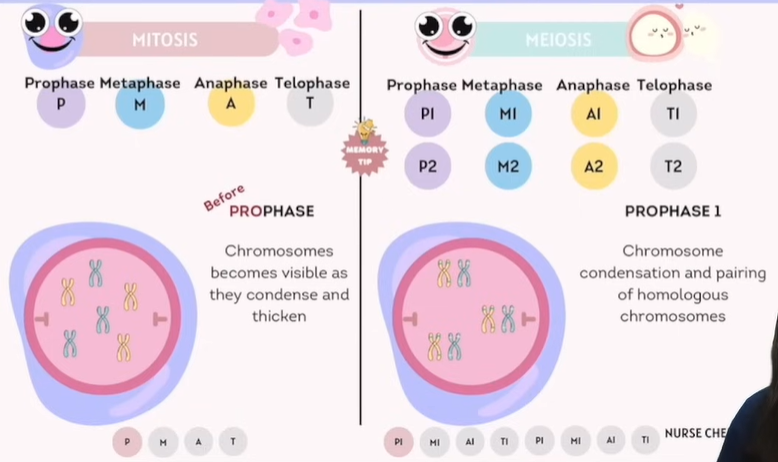
Mitosis & Meiosis MetaPhase (M=Middle)
Mitosis MetaPhase | Chromosomes align in the middle of the cell’s center, forming a single row. |
Meiosis Metaphase 1 | Chromosomes align in the middle of the cell’s center and maintain their homologous pairs. |
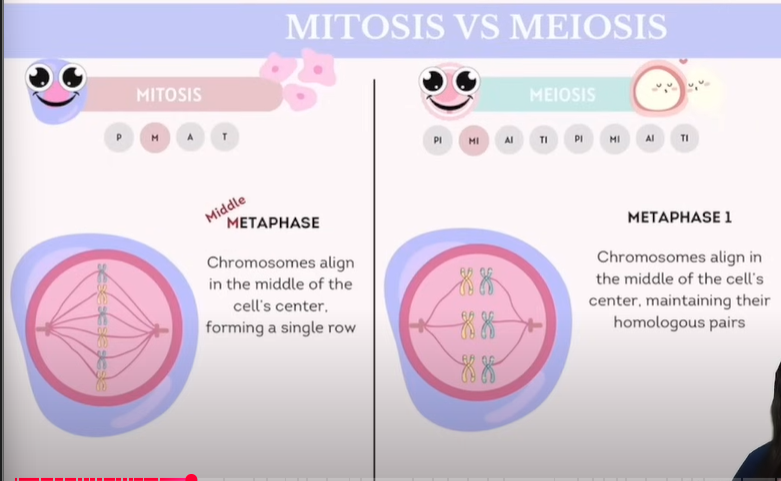
Mitosis & Meiosis AnaPhase (A=Away)
Mitosis AnaPhase | Chromatids are separated and drawn to the opposite ends of the cell by spindle fibers |
Meiosis Anaphase 1 | Chromosomes are separated and drawn to the opposite ends of the cell by spindle fibers. #Allows random assortment of chromosomes, contributing to genetic diversity among offspring. |
Chromatids = 🧬 What Are Chromatids? ✅ Definition:
A chromatid is one-half of a duplicated chromosome.
When a chromosome is copied (during interphase), it forms two identical sister chromatids, joined at a point called the centromere.
📘 Simple Breakdown:
Term | Description |
|---|---|
Chromosome | A structure made of DNA and proteins that carries genetic info |
Chromatid | One copy of a chromosome after it has been duplicated |
Sister Chromatids | Two identical chromatids (joined at the centromere) |
Centromere | The central part where two sister chromatids are attached |
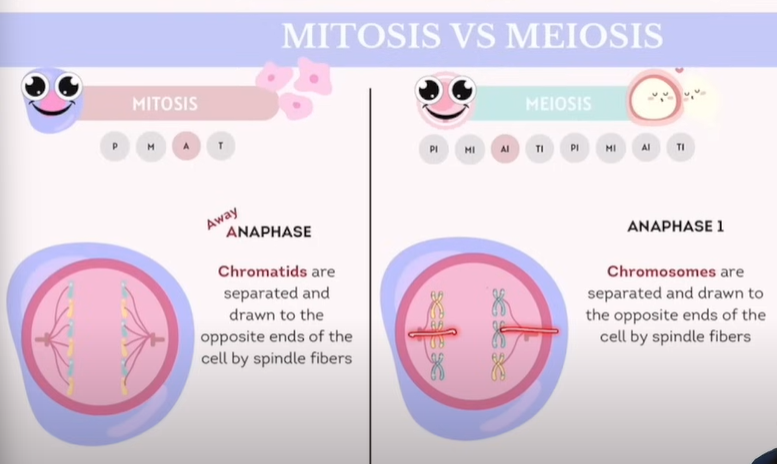
Mitosis & Meiosis TeloPhase
Mitosis TeloPhase | Chromosomes reach the opposite sides of the cell. Forming new nuclear envelopes around the chromosomes. |
Meiosis Telophase 1 | Chromosomes reach the opposite sides of the cell. Forming new nuclear envelopes around the chromosomes. |
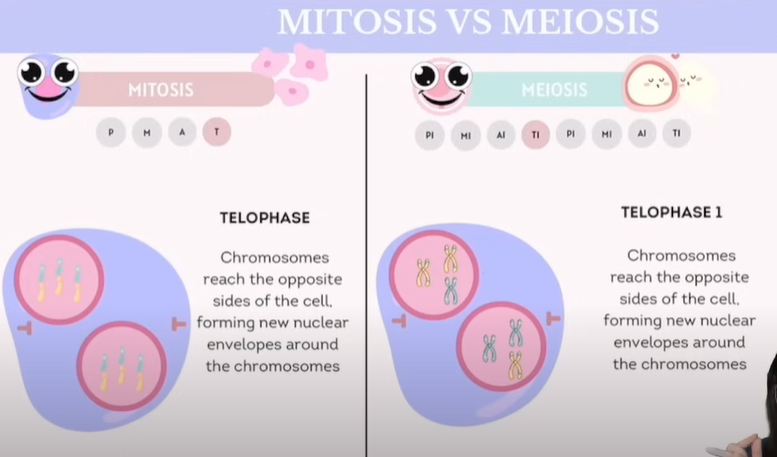
Mitosis & Meiosis - Cytokinesis
Mitosis Cytokinesis | Split the cytoplasm of the cell Two identical, diploid cells. |
Meiosis Cytokinesis | Split the cytoplasm of the cell |
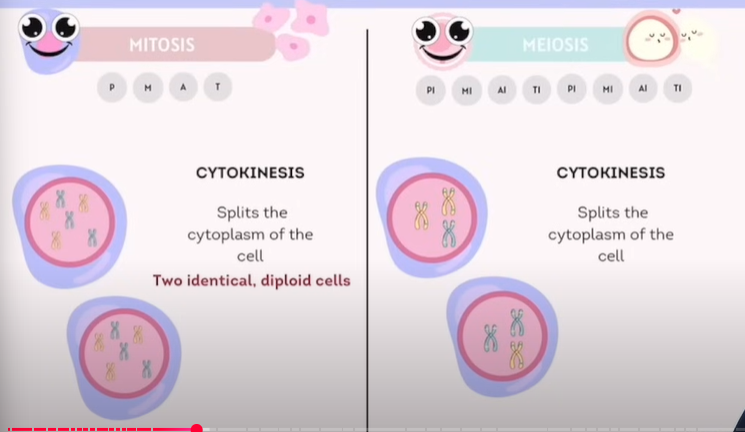
Meiosis Round 2
Meiosis Prophase 2 | Chromosome condensation in both cells |
Meiosis Metaphase 2 | Chromosomes align in the center of the cell. Forming a single row. |
Meiosis Anaphase 2 | Chromatids are separated and drawn to the opposite ends of the cell by spindle fibers. |
Meiosis Teloohase 2 | Chromosomes reach the opposite sides of the cell. Forming new nuclear envelopes around the chromosomes. |
Meiosis Cytokinesis | Split the cytoplasm of the cell. Four non-identical cells (Gametes) |
Heredity
The passing on of physical or mental characteristics genetically from one generation to another.
DNA - Deoxyribonucleic Acid
Nucleotide
Self-replicating material that is present in nearly all living organisms as the main constituent of Chromosomes.
"Nucleotide" 的中文是核苷酸。核苷酸是核酸(如 DNA 和 RNA)的基本組成單位,它由一個含氮鹼基、一個五碳糖和一个或多个磷酸基团组成。
Component | Description | Role/Function |
|---|---|---|
Double Helix Shape | Twisted ladder-like structure | Structure of DNA |
Nucleotide 核苷酸 | Building block of DNA | Makes up DNA strands |
Phosphate | Circle part of nucleotide | Part of DNA backbone |
Deoxyribose (A Sugar) | Pentagon-shaped sugar | Bonds phosphate and base (DNA backbone) |
Nitrogenous Base | Rectangular structure | Contains genetic code |
Code for Traits | Info carried by nitrogenous base | Determines genetic traits |
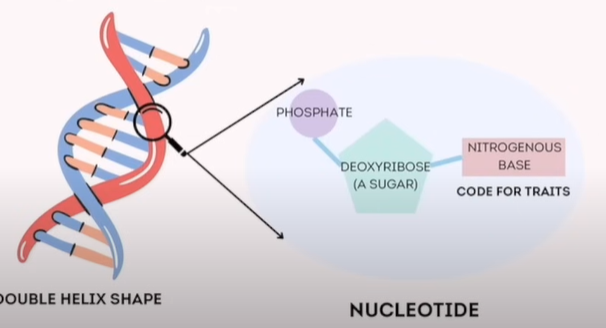
4 Kinds of Bases in DNA
Component | Explanation | Memory Aid |
|---|---|---|
DNA (Deoxyribonucleic Acid) | Self-replicating genetic material found in all living organisms | - |
Nucleotide Bases | The rungs of the DNA ladder, paired by hydrogen bonds | - |
Adenine (A) | Pairs with Thymine (T) | Apple in the Tree |
Thymine (T) | Pairs with Adenine (A) | Apple in the Tree |
Cytosine (C) | Pairs with Guanine (G) | Car in the Garage |
Guanine (G) | Pairs with Cytosine (C) | Car in the Garage |
Hydrogen Bonds | Weak bonds that hold base pairs together | - |
A - T
C - G
What is Gene?
The two types of Gene?
🔹 Flashcard-Style Questions:
1. Structural Genes
Q: What type of gene codes for traits like eye or hair color?
A: Structural genes.
Q: Name two functions of proteins coded by structural genes.
A: Enzymatic activity and defense mechanisms.
2. Regulatory Genes
Q: What is the role of regulatory genes?
A: To control the timing, location, and amount of gene expression.
Q: True or False: Regulatory genes can turn structural genes on or off.
A: True.
3. Protein and Gene Interaction
Q: Can proteins influence gene activity?
A: Yes, proteins can regulate genes or act as products of genes.
4. Gene Regulation
Q: What is gene regulation?
A: The control of gene expression in terms of timing, location, and quantity.
Q: What does gene regulation help an organism do?
A: Adapt and control development and cellular function.
A unit of Heredity which is transferred from a parent to offspring and is held to determine some characteristic of the offspring.
Category | Description | Examples/Functions |
|---|
Structural Genes | Code for proteins that affect the physical traits and basic functions of the body | Eye/hair color, transport proteins, enzymes, immunity |
Regulatory Genes | Control when, where, and how much structural genes are expressed | Gene regulation, activation/inactivation |
Protein Function | Proteins are made from gene instructions and can also influence other gene functions | Enzymes, transporters, hormones, structural roles |
Gene Regulation | The process that determines which genes get turned on or off | Controlled by r |
🔹 Extra TEAS-Related Concepts Not in Image:
Concept | Explanation |
|---|---|
Transcription | DNA is transcribed into mRNA |
Translation | mRNA is translated into proteins at the ribosome |
Mutations | Changes in DNA that can affect gene expression or protein function |
Epigenetics | Gene expression changes that don’t involve changes to the DNA sequence |
Homeobox (HOX) Genes | Regulatory genes that control body plan during embryonic development |
Operons (Prokaryotic gene regulation) | Units of genes in bacteria regulated together (e.g., lac operon) |
RNA - Ribonucleic Acid
A nucleic acid present in all living cells whose principal role is to act as a messenger carrying instructions from DNA for controlling the synthesis of protein.
Present is both in and outside of the nucleus.
Feature | RNA (Ribonucleic Acid) |
|---|---|
Structure | Single-stranded |
Sugar | Ribose (different from DNA's deoxyribose) |
Base Pairing Rule | Adenine pairs with Uracil (instead of Thymine) |
Base Names | Adenine (A), Uracil (U), Cytosine (C), Guanine (G) |
Location | Present inside and outside the nucleus |
Function | Messenger that carries DNA instructions for protein synthesis |
Memory Tip | "Apple under the tree" = A → U |
Pairing Tips:
Apple Under the tree
Car in the Garage
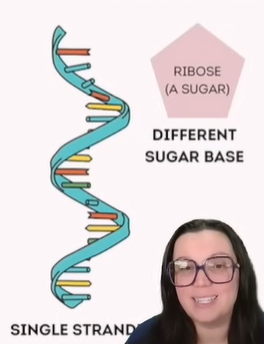
3 Types of RNA
Type of RNA | Full Name | Function | Visual Cue from Image |
|---|---|---|---|
mRNA | Messenger RNA | Carries genetic instructions from DNA( IN NUCLUES ) to the ribosome | Mail carrier |
rRNA | Ribosomal RNA | Forms part of the ribosome, the site of protein synthesis | Ribosome base structure |
tRNA | Transfer RNA | Transfers amino acids and matches them to mRNA codons | Adaptor decoding mRNA into protein |
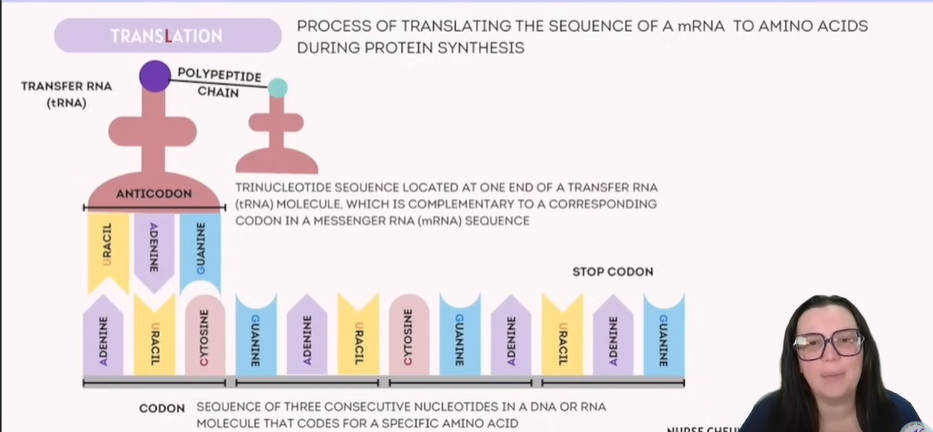
Transcription vs Translation
🎓 Flashcard Questions
1. Transcription
Q: Where does transcription occur in the cell?
A: In the nucleus.
Q: What enzyme is responsible for transcription?
A: RNA polymerase.
Q: What is the result of transcription?
A: A strand of mRNA.
2. Translation
Q: What is the purpose of translation?
A: To build a protein from the sequence on mRNA.
Q: What molecule brings amino acids to the ribosome?
A: tRNA (transfer RNA).
Q: Where does translation take place?
A: At the ribosome in the cytoplasm.
3. Both Together
Q: What is the correct order of the processes?
A: Transcription → Translation.
Q: What does mRNA do in protein synthesis?
A: It carries the genetic code from DNA to the ribosome.
Transcription: DNA → mRNA
Translation: mRNA →(Using Ribosome) Protein
Step | Transcription | Translation |
|---|---|---|
Definition | Making an RNA copy of a gene’s DNA sequence | Converting mRNA into a chain of amino acids (protein) |
Location | Nucleus (in eukaryotes) | Ribosome (cytoplasm) |
Main Molecule | RNA Polymerase | tRNA (transfer RNA) + Ribosome |
Product | mRNA (messenger RNA) | Polypeptide (protein chain) |
Memory Tip | “C comes before L” → Transcription comes before Translation | Translation happens after transcription |
Concept | Details |
|---|---|
Codons | 3-letter mRNA sequences that code for amino acids |
Start Codon | AUG — signals the start of translation |
Stop Codons | UAA, UAG, UGA signal the end of translation |
Mutation Effect | A DNA mutation can change mRNA → which may alter the amino acid/protein |
Role of Ribosomes | Ribosomes "read" mRNA and build proteins with the help of tRNA |
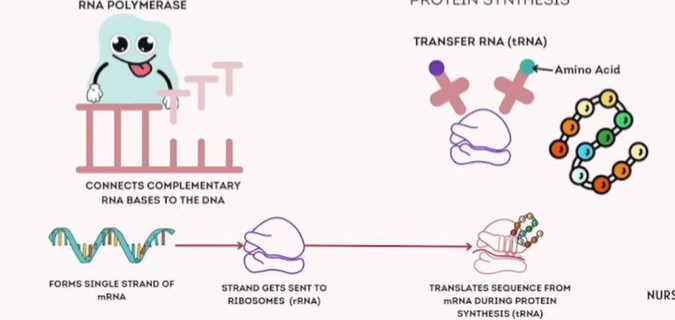
RNA Polymerase
🧬 RNA Polymerase – TEAS Exam Breakdown
RNA Polymerase is an enzyme essential in the transcription step of protein synthesis.
✅ Definition:
RNA Polymerase is the enzyme that:
Binds to DNA at the start of a gene.
Unzips the DNA strands.
Builds a complementary strand of RNA by matching RNA bases to the DNA template strand.
Transcription vs Translation Part 2
Codons, Anticodons, & Translation
🎓 Flashcard Questions
1. Codons & Anticodons
Q: What is a codon?
A: A 3-nucleotide sequence on mRNA that codes for an amino acid.
Q: Where is the anticodon found?
A: On tRNA.
Q: What does the anticodon do?
A: It pairs with the codon to ensure the correct amino acid is added.
2. Translation Process
Q: What is formed during translation?
A: A polypeptide chain (protein).
Q: What molecule carries amino acids to the ribosome?
A: tRNA.
Q: What signals the end of translation?
A: A stop codon.
Summary Table: Codons, Anticodons, & Translation
Term | Definition |
|---|---|
Translation | The process of converting mRNA into a chain of amino acids (a protein) |
Codon | A 3-letter sequence on mRNA that codes for an amino acid |
Anticodon | A complementary 3-letter sequence on tRNA that binds to the codon |
tRNA (transfer RNA) | Carries amino acids and matches codons using its anticodon |
Polypeptide Chain | A string of amino acids — final product of translation (protein) |
Stop Codon | Signals the end of translation — does not code for an amino acid |
🧠 Memory Tips:
Codon = Code (on mRNA)
Anticodon = Anti-match (on tRNA)
tRNA = Taxi that drops off the right amino acid
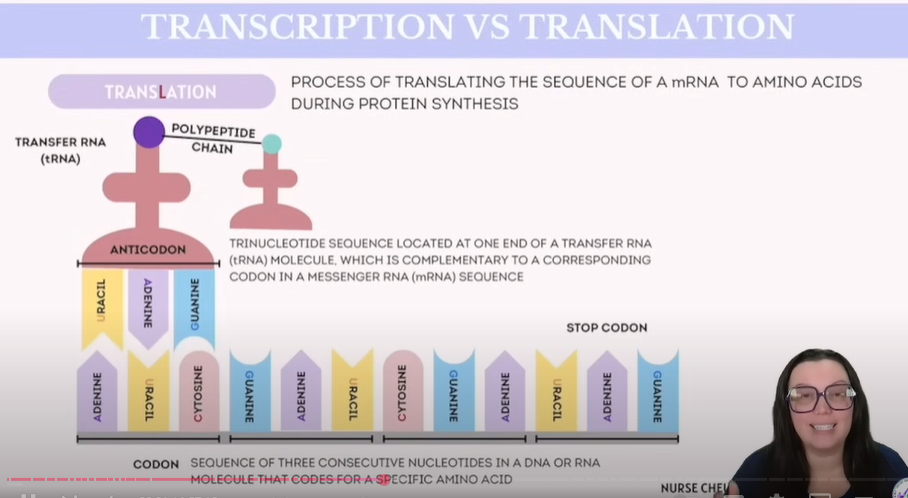
Transcription vs Translation Flow
🧬 Types of Mutations (DNA Level)
Mutations are changes in the DNA sequence, and they can affect proteins in different ways depending on the type.
What are the two categories and what included in each.
🔷 1. DNA-Level Mutations (Type of Base Change)
DNA-Level Categories → Describes what kind of base change happened.
Mutation Type | What It Means |
|---|---|
Transition A-A | A purine ↔ purine (A ↔ G) or pyrimidine ↔ pyrimidine (C ↔ T) |
Transversion A-B | A purine ↔ pyrimidine (A or G ↔ C or T) |
🧠 Key point:
These may or may not affect the protein — they only describe the DNA substitution type.
🔶 2. Protein-Level Mutations (Effect on Protein)
These describe what happens to the resulting protein after the DNA mutation.
Mutation Type | What It Means |
|---|---|
Missense | Base change → changes amino acid |
Nonsense | Base change → creates stop codon |
Frameshift | Insertion/deletion → shifts reading frame, changing entire protein |
Silent | DNA base changes, but amino acid stays the same (due to codon redundancy) |
🧠 Key point:
These always affect the protein structure or function.
✅ How This Helps:
Transition/transversion = what changed in the DNA
Silent/missense/nonsense/frameshift = what that change caused
🧬 Example:
GAG → GTG
Base A → T = transversion mutation (DNA-level)
Glutamic acid → valine = missense mutation (protein-level)
💡 Types of Genetic Mutations Quiz
🧬 Sickle Cell Anemia
Cause: A point mutation (a single base substitution) in the hemoglobin-beta gene.
Specifically, the DNA mutation changes the codon GAG (which codes for glutamic acid) to GTG (which codes for valine).
This change causes hemoglobin to form abnormally — leading to sickle-shaped red blood cells.
🧪 Type of Mutation:
This is a missense mutation because:
The mutation changes one amino acid to another.
It’s not a silent mutation (which doesn’t change the amino acid).
It’s not a deletion mutation (which removes a base).
It’s a substitution, more specifically a:
Transversion mutation → a purine is replaced by a pyrimidine, or vice versa.
✅ Correct answer: Transversion mutation
📚 Flashcard-Style Questions for TEAS Practice:
1. What type of mutation causes sickle cell anemia?
A. Silent mutation
B. Deletion mutation
C. Transition mutation
D. Transversion mutation
✅ Answer: D. Transversion mutation
2. What happens in a missense mutation?
A. One base is deleted, shifting the reading frame.
B. A base substitution causes one amino acid to change.
C. The sequence of amino acids remains unchanged.
D. The gene is completely removed.
✅ Answer: B. A base substitution causes one amino acid to change.
3. Which of the following best describes a silent mutation?
A. It changes the amino acid completely.
B. It replaces a purine with a pyrimidine.
C. It changes the DNA base but does not affect the protein.
D. It results in a sickle-shaped red blood cell.
✅ Answer: C. It changes the DNA base but does not affect the protein.
4. A mutation that results in a stop codon is called:
A. Silent mutation
B. Nonsense mutation
C. Missense mutation
D. Frameshift mutation
✅ Answer: B. Nonsense mutation
🧬 Types of DNA Mutations
Mutation Type | Description | Example | Possible Effect |
|---|---|---|---|
Substitution | One base (nucleotide) is replaced by another |
| Can be silent, missense, or nonsense |
Insertion | One or more extra bases are added into the DNA |
| Can shift the reading frame (frameshift) |
Deletion | One or more bases are removed from the DNA |
| Can also cause a frameshift |
Duplication | A section of DNA is copied and repeated |
| Can alter protein function |
Inversion | A segment of DNA is flipped in orientation |
| May disrupt gene regulation or coding |
Translocation | A segment of DNA is moved to a different part of the genome (often between chromosomes) | — | Often disrupts multiple genes; may lead to cancer |
🧬 Disjunction vs. Nondisjunction
🧬 Disjunction vs. Nondisjunction
Term | Definition | When It Happens | Result |
|---|---|---|---|
Disjunction | The normal separation of homologous chromosomes or sister chromatids | Meiosis I, Meiosis II, or mitosis | Each daughter cell gets the correct number of chromosomes |
Nondisjunction | The failure to separate chromosomes properly | Meiosis I or II, or mitosis | Causes cells with too many or too few chromosomes |
🔬 More Detail: ✅ Disjunction (Normal)
In Meiosis I: Homologous chromosomes separate
In Meiosis II: Sister chromatids separate
➡ Each gamete gets one copy of each chromosome
❌ Nondisjunction (Abnormal)
Homologous chromosomes don’t separate in Meiosis I
Sister chromatids don’t separate in Meiosis II
➡ Gametes end up with 0 or 2 copies of a chromosome instead of 1
🚨 Results of Nondisjunction
Condition | Chromosome Affected | Result |
|---|---|---|
Down syndrome | Trisomy 21 | 3 copies of chromosome 21 |
Turner syndrome | Monosomy X (45,X) | Only one X chromosome in females |
Klinefelter syndrome | XXY (47 chromosomes) | Extra X chromosome in males |
🎓 TEAS Tip:
Nondisjunction = incorrect separation
Happens during anaphase of meiosis or mitosis
Leads to aneuploidy (abnormal chromosome number)